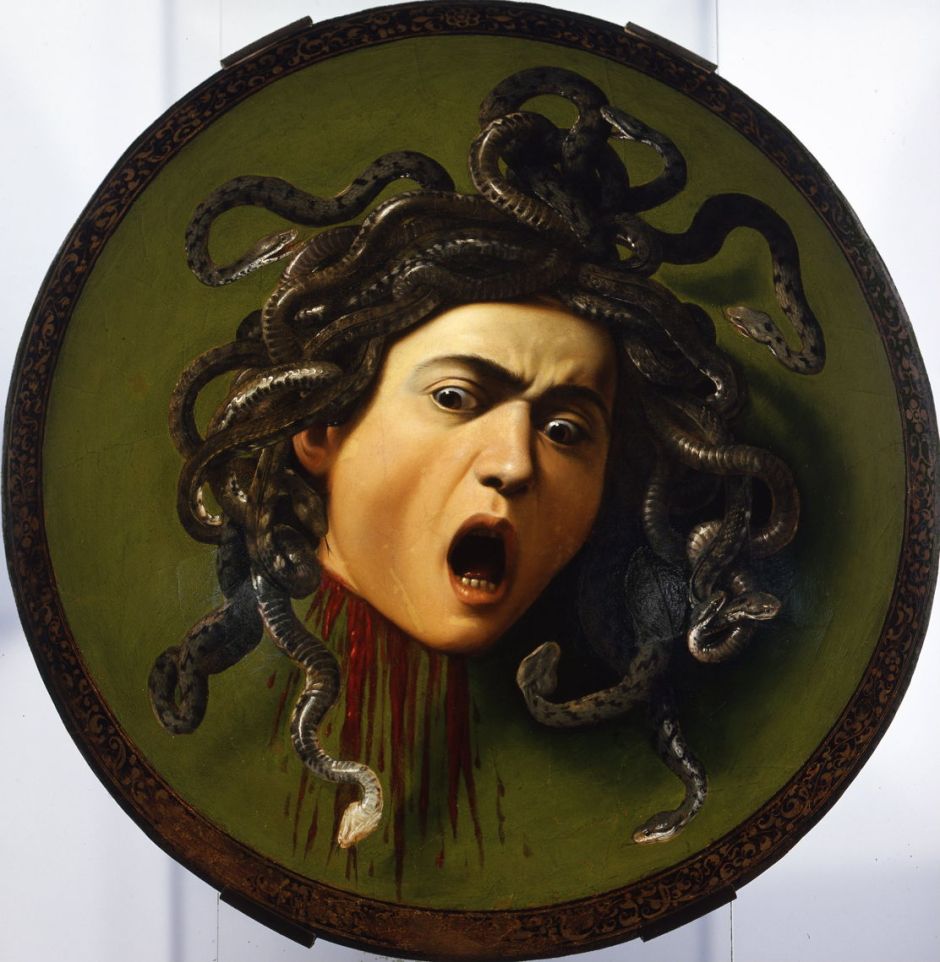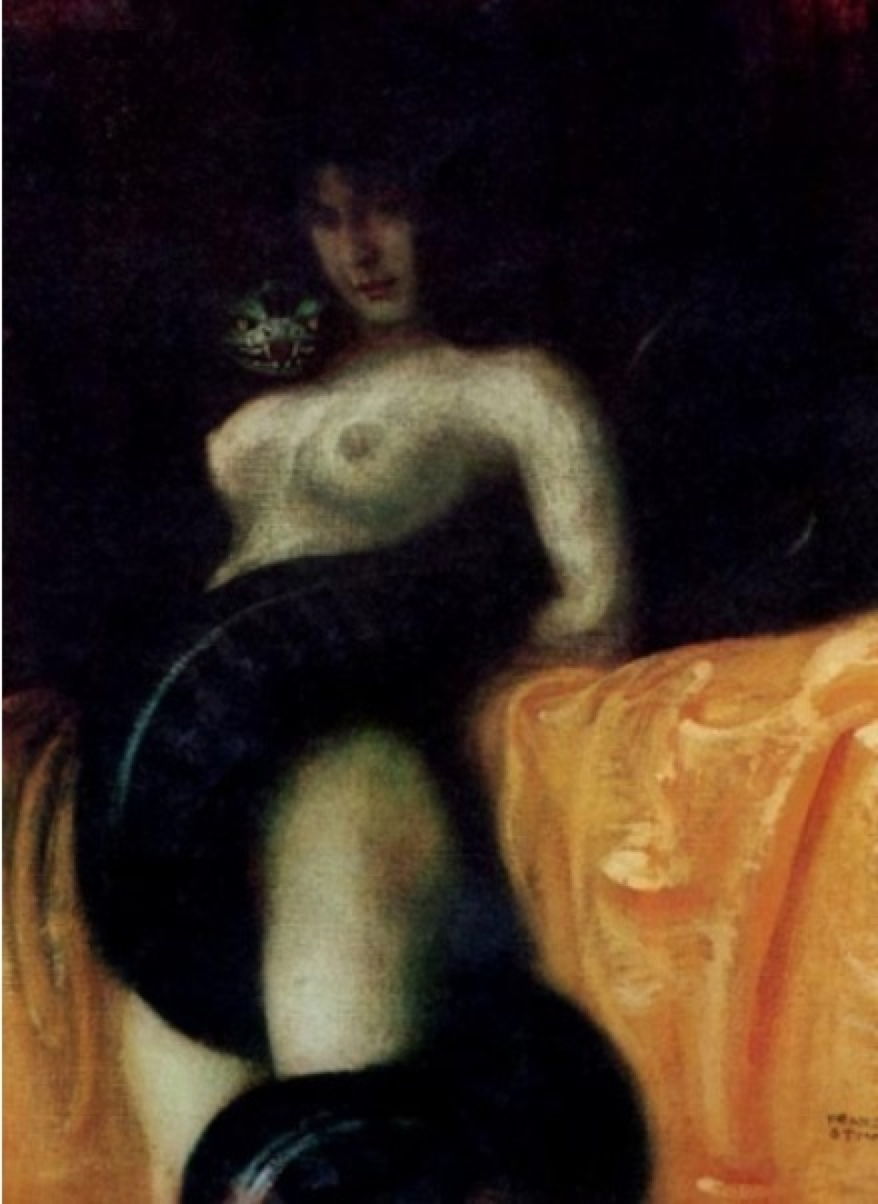Snakes or serpents appear so often in both verbal and visual narrative that it seems likely that in the Fertile Crescent and Mediterranean coast they were not uncommon in the past. Their major association is with things sinister and evil, and they feature in many myths, legends and religious writings.
The gorgon Medusa is a popular example from the Perseus myths of a formerly beautiful woman whose head is adorned by snakes.

Her most enduring and familiar image is Caravaggio’s Medusa from about 1597, which follows traditional lines, with ample blood and abundant snakes, and captures the open-mouthed horror in her face after decapitation by Perseus. Her face is thoroughly human, which is in accord with literary accounts. Its danger rests in the fact that any mortal seeing her face directly (in contrast to seeing its reflection) is immediately turned to stone.

In Eurydice and the Serpent, a pastel from 1915, Ker-Xavier Roussel shows the fateful introductory scene in the well-known story taking the master musician Orpheus into the Underworld. Immediately after Orpheus and Eurydice had married, she was bitten by a snake, and died in her husband’s arms. The conventional painting made of this shows that last moment in Eurydice’s life; Roussel chooses a few moments earlier, with the snake seen on the ground in front of her.

Sargent’s large masterpiece Orestes Pursued by the Furies was started in 1922, and completed in 1925, just prior to his death. Over its 100 square feet of canvas, it shows a young and naked Orestes cowering under the attacks of the Furies, as he tries to run from them. The swarm of no less than a dozen fearsome Furies have daemonic mask-like faces, blond hair swept back, and hold out burning brands and fistfuls of small snakes.
Sargent has gilded the flames on the brands, which makes them shine proud like fire. The isolated woman who stands in Orestes’ way is no Fury, though: she wears a gilded crown, and with the clean incision of a stab wound above her left breast can only be his mother, Clytemnestra.
Classical myth associates snakes with sorcery and the dark arts.

JMW Turner’s Vision of Medea from 1828, is the first in a series of more modern attempts to tell Medea’s story. She stands in the midst of an incantation to force Jason’s return to her. In the foreground are the materials to cast her spell: flowers, snakes, and other supplies of a sorceress. Seated by her are the Fates. In the upper right, Medea is shown again in a flash-forward to her fleeing Corinth in a chariot drawn by dragons, the bodies of her children thrown down after their deaths.
Judeo-Christian accounts of the creation put a serpent at the centre of the Fall of Man.

The cherubic head in Rubens’ painting of The Fall of Man, based loosely on Titian’s original, is that of the Devil in the guise of an anthropomorphic serpent, who hands Eve the apple which brought about expulsion from God’s Garden of Eden.

William Blake’s exuberant and draconian serpent has caught Eve in its calligraphic coils, in his glue tempera painting on copper of Eve Tempted by the Serpent (1799-1800). This relies not only of the biblical narrative from Genesis chapter 3, but also Milton’s elaboration in his epic Paradise Lost. Eve is to blame for what happened both to her and to Adam.

Nicolas Poussin’s painting of the season of Winter or Flood (c 1660-64) returns to the Book of Genesis, to show the great flood, with lightning crackling through the sky, and a few survivors trying to escape the rising waters. Poussin also expresses his lifelong dread of snakes: one is slithering up the rocks on the left, and from memory I think that there is another in the water, although I can’t see it in this image.

Snakes reappear in some of Poussin’s other paintings. Landscape with Two Nymphs and a Snake (c 1659), for example, greets the gaze with two partially nude women, reclining beside a small lake and a large urn, who have turned round to look at a very large snake, which is close to them but no immediate threat. A decade earlier, he had painted his famously enigmatic Landscape with a Man Killed by a Snake (1648).
Snakes were seen as punishment, for example in Dante’s Inferno.

William Blake had a longstanding obsession with Dante’s Divine Comedy. At the end of Blake’s career, he was commissioned by the artist John Linnell to produce a set of illustrations, which remained incomplete at the time of his death in 1827. The Punishment of the Thieves (1824–7), anticipates figurative painting of a century or more later, and the darker psychological recesses of sex and snakes. Dante refers to the thieves being bitten by snakes, but Blake uses the creatures in other ways.
As the femme fatale developed in literature and visual art, so accounts referred back to Eve and older mythological associations.

Piero di Cosimo’s well-known portrait of a woman claimed to be Simonetta Vespucci from 1490 is one of the earliest to explore the theme of the femme fatale. Simonetta was reputed to have been the most beautiful woman in the whole of northern Italy, and was a favourite at the court of the de’ Medicis. In 1475, Giuliano de’ Medici entered a jousting tournament bearing a banner on which Botticelli had painted an image of Simonetta as Pallas Athene. But she died the following year of tuberculosis, at the age of only twenty-two. The melanistic adder wrapped around her necklace may be a reference to Cleopatra’s suicide by the venom of an asp, and marks her out as a femme fatale.

When Gaston Bussière painted the femme fatale Salammbô in 1920, she underwent Salomean conversion. Standing naked and flirtatious beside an extraordinarily erect snake, she may be in a temple, but is a glowing pagan goddess of seduction. This painting is in the Musée des Ursulines in Mâcon, France, which occupies the site of a former convent.

Along with other artists such as Gustave Moreau and Lovis Corinth, Franz von Stuck returned repeatedly to the theme of the femme fatale. Here she is, in a painting from about 1893, as Sin. Coiled between her legs with its head resting on her right shoulder is the largest serpent you could ever imagine.

John Collier’s painting of Lilith from 1892 invokes an even older mythology probably dating back to the Epic of Gilgamesh and the early civilisations of Mesopotamia. A sexually wanton daemon of the night, she has been claimed to be Adam’s original wife, and created from the same clay as he was. Although not involved in the Original Sin, she’s associated with a serpent apparently related to von Stuck’s.
There is, though, one ancient myth that puts serpents in a better light, that of Aesculapius, god of healing.

There is much about Aesculapius which is unusual. His main attribute is a rod or staff, around which there is normally but a single snake, which is associated with healing and medicine, and still widely used as a medical symbol. In the eighteenth century, Giovanni Battista Cipriani drew Aesculapius Holding a Staff Encircled by a Snake, following this classical tradition.
Tomorrow I’ll look at some less familiar associations of snakes, this time with the Virgin Mary.

